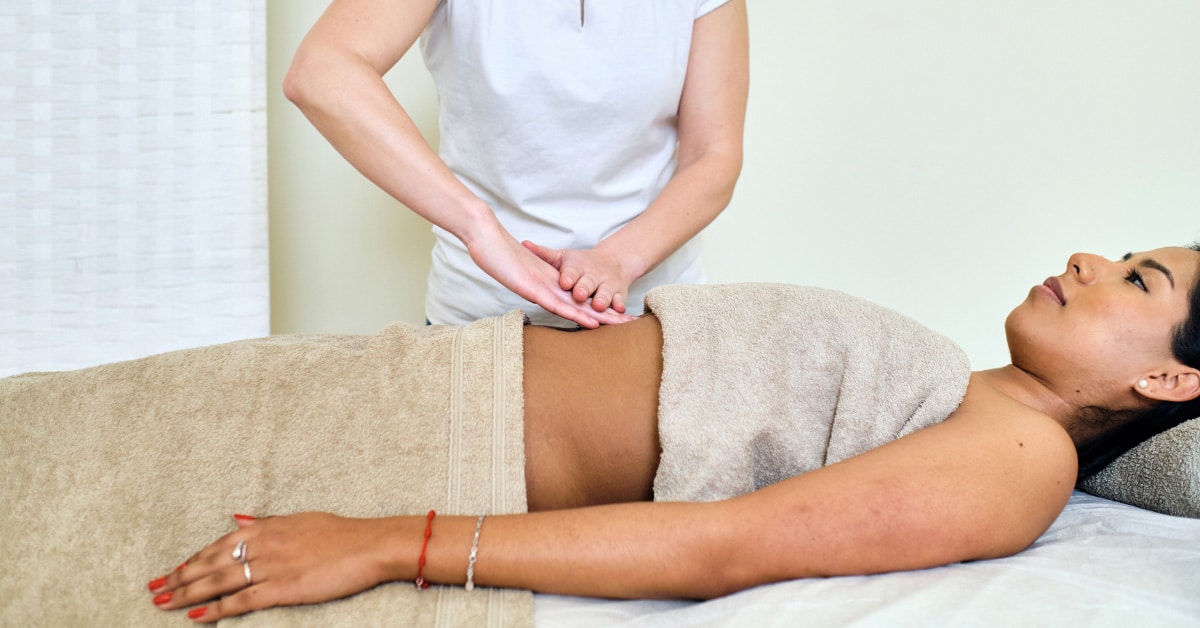Post-operative swelling and discomfort, whether from general surgery, plastic surgery procedures like liposuction, or a tummy tuck, can be quite concerning.
Understanding Lymphatic Drainage Massage
Lymphatic drainage massage is a specialized form of gentle massage that encourages the movement of lymph fluids around the body, which can aid in reducing swelling and promoting overall well-being.
The primary aim is to enhance the body’s ability to remove toxins. Those new to this therapeutic technique should know that it operates on the principles of stimulating the lymphatic system to clear blockages and facilitate immune function.
Its benefits extend beyond mere relaxation, offering a profound impact on the healing process. By ensuring lymph fluid circulates efficiently, it can help diminish post-operative swelling significantly. Consequently, it is essential to consult your doctor to determine the appropriate timing for such massages post-surgery, ensuring it aligns with your unique recovery process.
Benefits of Lymphatic Drainage Massage After Surgery
Lymphatic drainage massage offers numerous advantages post-surgery, including after a tummy tuck or mommy makeover.
Firstly, it significantly accelerates recovery by reducing swelling. The gentle technique helps in moving excess fluids, which often accumulate in tissues post-surgery, thus promoting faster healing. It can lessen pain and discomfort by alleviating pressure from swollen areas, which contributes to enhanced mobility.
Such relief is crucial for minimizing scar tissue. Its therapeutic nature fosters better overall health – not only does it expedite recovery, but it also boosts immune function, ensuring the body remains resilient during the healing period.
Its positive influence on emotional well-being cannot be overstated; relaxation induced by the massage contributes to lower stress levels. This, in turn, promotes a more positive outlook on recovery, thus complementing the physical benefits with equally important mental health advantages.
Timeline for Lymphatic Drainage Massage After Surgery
A question that often arises among patients is how soon after surgery can you get a lymphatic drainage massage?
In general, healthcare professionals recommend waiting at least one-week post-surgery before beginning a lymphatic drainage massage. This waiting period allows the initial phase of swelling and inflammation to subside, providing a safer environment for the gentle massaging techniques used.
However, it’s critical to consult with your surgeon or healthcare provider before initiating such treatments. They can offer personalized advice based on the specifics of your surgery and individual health status, ensuring optimal recovery conditions.
Once clearance is obtained, starting with light and gradual sessions can be prudent. This mindful approach reduces any potential risk while reaping the myriad benefits discussed previously, including reduced swelling and enhanced immune function, contributing to a stronger immune system.
Ultimately, adhering to professional guidance ensures you’re taking the right steps toward a faster, healthier recovery while maximizing the holistic advantages of lymphatic drainage massage.
Signs You’re Ready for a Lymphatic Drainage Massage
You’re noticing a significant reduction in swelling, and several weeks have passed since your cosmetic surgery without any signs of complications. Your surgical wound has had ample time to start the healing process, with no indication of infection or excessive redness. Additionally, you’re finding normal activities less painful and generally feeling well.
You’ve obtained medical clearance and discussed manual lymphatic drainage massage as well as lymphatic massage with your surgeon or healthcare provider. Your mobility has improved, allowing you to move more freely without the initial post-surgery stiffness. This enhanced range of motion often indicates reduced inflammation and a greater readiness for massage therapies.
Your body also shows signs of detoxifying naturally, such as clearer skin and better digestion, suggesting that your lymphatic system is functioning well. If this aligns with your recovery plan according to 2023 standard surgical guidelines, these indicators collectively suggest you’re ready to benefit from the restorative potential of lymphatic massage, setting you on the path to an optimal recovery.
Risks of Getting a Massage Too Soon
Getting a lymphatic drainage massage too soon after surgery poses significant risks. Premature intervention can aggravate the surgical site, leading to fluid buildup and other complications, thereby highlighting the importance of proper postoperative care.
On top of that, unnecessary pressure on sensitive tissues may impede proper healing. This interference may manifest as increased swelling, heightened pain, or even post-operative infection.
Any early exposure to such therapies can disrupt the body’s natural recovery process and may result in a prolonged healing timeline. A balanced approach, incorporating the advice of medical professionals, ensures a safer and more effective recuperation.
Preparing for a Lymphatic Drainage Massage
Preparing for a lymphatic drainage massage involves a few key steps to ensure the best results. Begin by staying hydrated—drinking plenty of water before your session helps to flush toxins from your body and supports the lymphatic system. Wear comfortable, loose-fitting clothing to your appointment to allow for easy access to areas that need treatment and to help you relax. Avoid consuming heavy meals or caffeine right before your massage, as these can make you feel uncomfortable during the session. Lastly, consult with your healthcare provider to ensure that lymphatic drainage massage is suitable for your specific health needs and recovery stage. Taking these steps will help you get the most out of your massage experience.
How Frequently to Get Lymphatic Drainage Massages
Regularity is key for optimal recovery benefits, especially in ensuring your lymph nodes are functioning properly.
Initially, following cosmetic or plastic surgery, many find that weekly sessions yield the best results. This frequent schedule aids in reducing swelling, and bruising, promoting circulation, and accelerating healing. However, your frequency should be personalized, and aligned with your specific condition and progression as advised by your healthcare provider.
Chronic conditions may necessitate more frequent visits.
Over time, as your body begins to heal and adapt, the frequency of sessions can be reduced. Many individuals might then transition to bi-weekly or even monthly maintenance appointments.
Ultimately, the ideal frequency of lymphatic drainage massages, including regular lymphatic massage sessions, hinges upon your unique needs, goals, and response to treatment. Consulting with both your therapist and healthcare provider ensures a tailored and effective plan that enhances your well-being.
Monitoring Your Progress and Recovery
As you embark on your recovery journey, regularly monitoring your progress becomes paramount, weaving a seamless connection between your body’s healing processes and a revitalized state of health.
Consistent check-ins with your healthcare provider ensure you’re on the right path.
Meticulously noting any changes—increased mobility, reduced swelling, or general well-being—provides valuable insights.
Such observations must be communicated to both your therapist and healthcare professional.
This shared knowledge fosters an adaptive approach, enabling personalized adjustments to your lymphatic massage schedule, and overall care plan.
Remember, the goal is not just recovery but thriving health. Your dedicated attention to progress will empower you.


